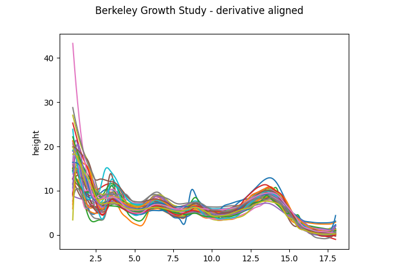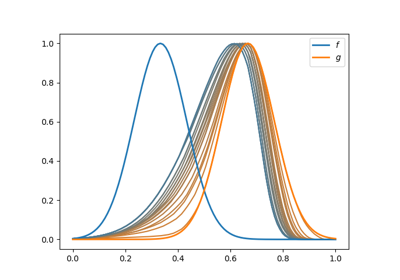FisherRaoElasticRegistration#
- class skfda.preprocessing.registration.FisherRaoElasticRegistration(*, template=<function fisher_rao_karcher_mean>, penalty=0, output_points=None, grid_dim=7, derivative_method=None)[source]#
Align a FDatagrid using the SRSF framework.
Let \(f\) be a function of the functional data object wich will be aligned to the template \(g\). Calculates the warping wich minimises the Fisher-Rao distance between \(g\) and the registered function \(f^*(t)=f(\gamma^*(t))=f \circ \gamma^*\).
\[\gamma^* = argmin_{\gamma \in \Gamma} d_{\lambda}(f \circ \gamma, g)\]Where \(d_{\lambda}\) denotes the extended Fisher-Rao distance with a penalty term, used to control the amount of warping.
\[d_{\lambda}^2(f \circ \gamma, g) = \| SRSF(f \circ \gamma) \sqrt{\gamma'} - SRSF(g)\|_{\mathbb{L}^2}^2 + \lambda \mathcal{R}(\gamma)\]In the implementation it is used as penalty term
\[\mathcal{R}(\gamma) = \|\sqrt{\gamma'}- 1 \|_{\mathbb{L}^2}^2\]Wich restrict the amount of elasticity employed in the alignment.
The registered function \(f^*(t)\) can be calculated using the composition \(f^*(t)=f(\gamma^*(t))\).
If the template is not specified it is used the Karcher mean of the set of functions under the elastic metric to perform the alignment, also known as elastic mean, wich is the local minimum of the sum of squares of elastic distances. See
elastic_mean().In [1] are described extensively the algorithms employed and the SRSF framework.
- Parameters:
template (Union[FDataGrid, _MeanType]) – Template to align the curves. Can contain 1 sample to align all the curves to it or the same number of samples than the fdatagrid. By default elastic mean, in which case
elastic_mean()is called.penalty_term – Controls the amount of elasticity. Defaults to 0.
output_points (Optional[ArrayLike]) – Set of points where the functions are evaluated, by default uses the sample points of the fdatagrid which will be transformed.
grid_dim (int) – Dimension of the grid used in the DP alignment algorithm. Defaults 7.
derivative_method (Optional[Basis]) – Method to use to compute the derivative. If
None(the default), finite differences are used. In a basis object is passed the grid is converted to a basis representation and the derivative is evaluated using that representation.penalty (float) –
- Attributes:
template_ – Template learned during fitting, used for alignment in
transform().warping_ – Warping applied during the last transformation.
References
Examples
Elastic registration of with train/test sets.
>>> from skfda.preprocessing.registration import ( ... FisherRaoElasticRegistration, ... ) >>> from skfda.datasets import make_multimodal_samples >>> X_train = make_multimodal_samples(n_samples=15, random_state=0) >>> X_test = make_multimodal_samples(n_samples=3, random_state=1)
Fit the transformer, which learns the elastic mean of the train set as template.
>>> elastic_registration = FisherRaoElasticRegistration() >>> elastic_registration.fit(X_train) FisherRaoElasticRegistration(...)
Registration of the test set.
>>> elastic_registration.transform(X_test) FDataGrid(...)
Methods
fit(X[, y])Fit the registration model.
fit_transform(X[, y])Fit the registration model and return the registered data.
Get metadata routing of this object.
get_params([deep])Get parameters for this estimator.
inverse_transform(X[, y])Reverse the registration procedure previosly applied.
score(X[, y])Return the percentage of total variation removed.
set_output(*[, transform])Set output container.
set_params(**params)Set the parameters of this estimator.
transform(X[, y])Register new data.
- fit_transform(X, y=None, **fit_params)[source]#
Fit the registration model and return the registered data.
- get_metadata_routing()#
Get metadata routing of this object.
Please check User Guide on how the routing mechanism works.
- Returns:
routing – A
MetadataRequestencapsulating routing information.- Return type:
MetadataRequest
- get_params(deep=True)#
Get parameters for this estimator.
- inverse_transform(X, y=None)[source]#
Reverse the registration procedure previosly applied.
Let \(gamma(t)\) the warping applied to construct a registered functional datum \(f^*(t)=f(\gamma(t))\).
Given a functional datum \(f^*(t) it is computed :math:\)gamma^{-1}(t)` to reverse the registration procedure \(f(t)=f^*(\gamma^{-1}(t))\).
- Parameters:
- Returns:
Functional data compose by the inverse warping.
- Raises:
ValueError – If the warpings \(\gamma\) were not build via
transform()or if the number of samples of X is different than the number of samples of the dataset previously transformed.- Return type:
Examples
Center the datasets taking into account the misalignment.
>>> from skfda.preprocessing.registration import ( ... FisherRaoElasticRegistration, ... ) >>> from skfda.datasets import make_multimodal_samples >>> X = make_multimodal_samples(random_state=0)
Registration of the dataset.
>>> elastic_registration = FisherRaoElasticRegistration() >>> X = elastic_registration.fit_transform(X)
Substract the elastic mean build as template during the registration and reverse the transformation.
>>> X = X - elastic_registration.template_ >>> X_center = elastic_registration.inverse_transform(X) >>> X_center FDataGrid(...)
See also
- score(X, y=None)[source]#
Return the percentage of total variation removed.
Computes the squared multiple correlation index of the proportion of the total variation due to phase, defined as:
\[R^2 = \frac{\text{MSE}_{phase}}{\text{MSE}_{total}},\]where \(\text{MSE}_{total}\) is the mean squared error and \(\text{MSE}_{phase}\) is the mean squared error due to the phase explained by the registration procedure. See
AmplitudePhaseDecompositionfor a detailed explanation.
- set_output(*, transform=None)#
Set output container.
See Introducing the set_output API for an example on how to use the API.
- Parameters:
transform ({"default", "pandas"}, default=None) –
Configure output of transform and fit_transform.
”default”: Default output format of a transformer
”pandas”: DataFrame output
”polars”: Polars output
None: Transform configuration is unchanged
New in version 1.4: “polars” option was added.
- Returns:
self – Estimator instance.
- Return type:
estimator instance
- set_params(**params)#
Set the parameters of this estimator.
The method works on simple estimators as well as on nested objects (such as
Pipeline). The latter have parameters of the form<component>__<parameter>so that it’s possible to update each component of a nested object.- Parameters:
**params (dict) – Estimator parameters.
- Returns:
self – Estimator instance.
- Return type:
estimator instance
Examples using skfda.preprocessing.registration.FisherRaoElasticRegistration#

Voice signals: smoothing, registration, and classification


